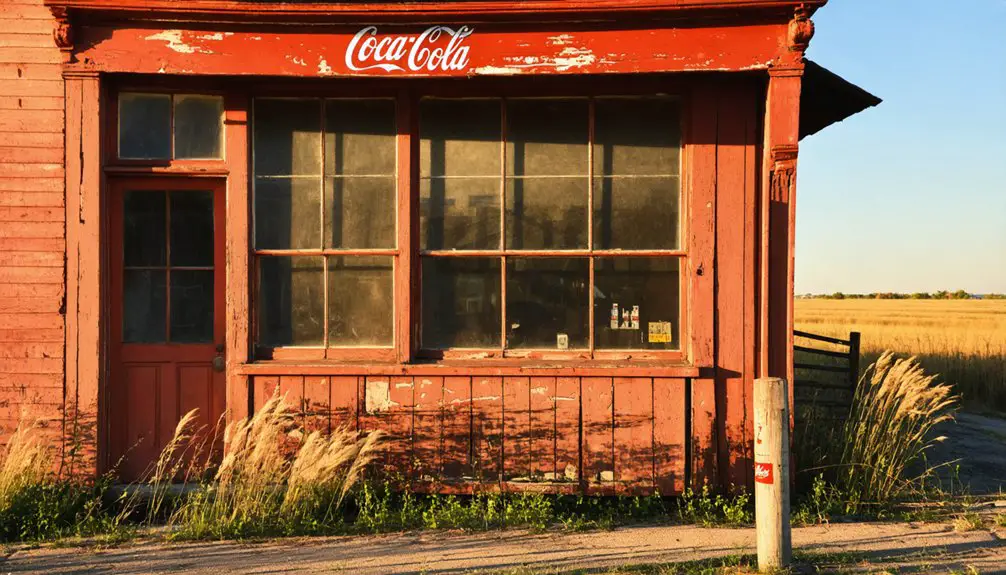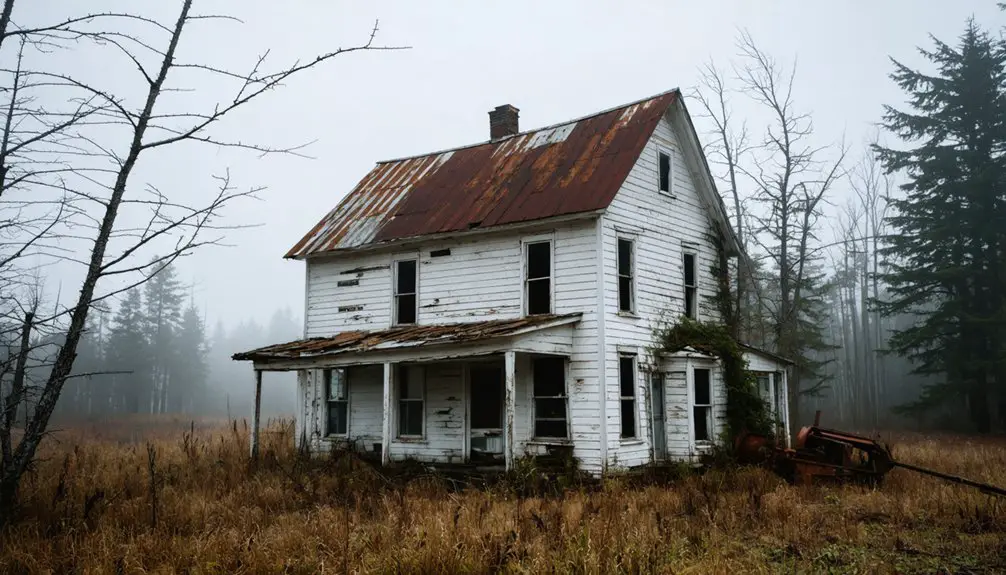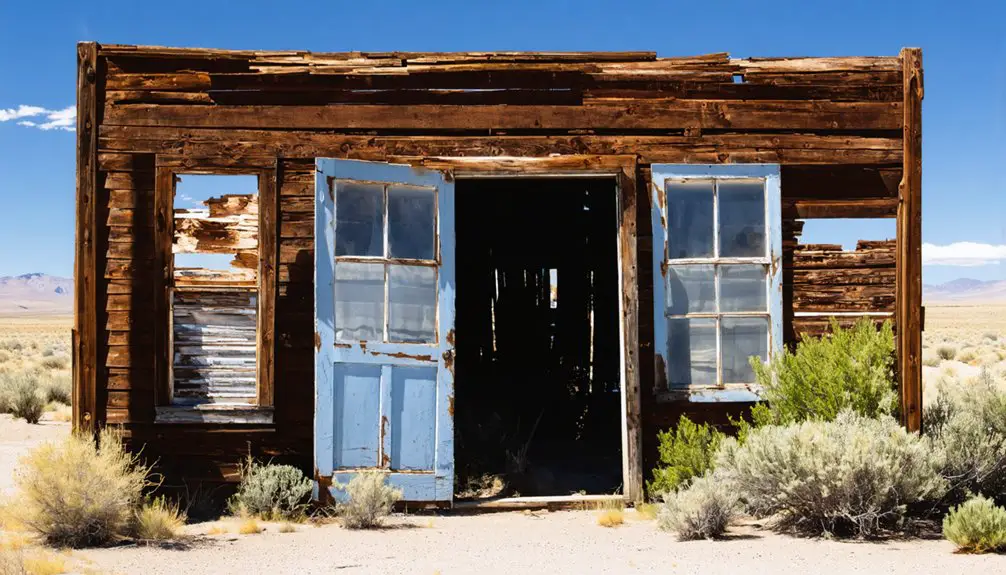You’ll find Bordeaux’s ghost town ruins in Washington’s Black Hills, where a thriving logging empire operated from 1903 to 1941. The company town, home to 400 residents, featured a shingle mill, sawmill, and 85 miles of logging railroad that connected to Seattle and Tacoma. At its peak, workers produced 250,000 shingles daily and processed millions of board feet of timber. Today, crumbling brick walls and old mill foundations tell the story of this once-bustling industrial center.
Key Takeaways
- Bordeaux was a thriving logging company town that housed 400 residents and operated extensive timber operations until its closure in 1941.
- The town featured essential amenities including a post office, school, hotel, general store, and 85 miles of logging railroad.
- The Bordeaux brothers established the town’s logging empire through the Mumby Lumber & Shingle Company in the early 1900s.
- The town declined when timber resources were depleted, leading to land sales to Washington state starting in 1933.
- Today, Bordeaux exists as protected archaeological ruins featuring remnants of sawmills, brick walls, and bridge footings from its logging era.
The Rise of a Logging Empire
Three key forces converged to establish Washington’s dominant logging empire in the late 1800s: technological innovation, railroad expansion, and aggressive land acquisition.
Innovation, railroads, and land grabs – the powerful trio that built Washington state’s timber empire in the nineteenth century.
As you explore the roots of this timber trade empire, you’ll find that steam-powered equipment revolutionized logging techniques, allowing crews to tackle previously unreachable forests. The invention of the donkey engine transformed the efficiency of log removal operations. The Shay locomotive provided powerful traction on steep terrain for transporting logs.
The arrival of railroads transformed everything – they weren’t just moving lumber, they were claiming vast tracts of forest through federal land grants.
By 1914, you could see logging’s incredible dominance, generating 55% of Northwest payrolls.
Companies like Hudson’s Bay had started modestly in 1828, but by the early 1900s, timber giants owned entire forests and company towns, controlling every aspect of production from tree to mill to market.
Life in the Company Town
If you’d lived in Bordeaux during its heyday, you’d have risen before dawn to the mill whistle’s call, joining hundreds of other workers streaming toward the sawmill for your 10-hour shift.
You’d have relied on the company store for all your basic needs, from groceries to work boots, while your children attended the company-built schoolhouse near the center of town.
After work, you might’ve gathered with fellow mill workers at the community hall for company-sponsored events, though your leisure time was limited by the demanding schedule of a six-day work week. The mill’s massive steam-powered donkey engines worked tirelessly throughout the day, hauling and loading logs onto waiting train cars.
Your work would have been grueling, as you were part of an industry that employed nearly two-thirds of Washington’s wage earners by 1910.
Daily Worker Routines
While Bordeaux’s workers faced demanding physical labor, their daily routines revolved around the town’s bustling lumber operations that employed roughly 300 men across various logging camps.
Thomas Bordeaux, who immigrated from Montreal in 1872, established strict work protocols for his lumber empire.
You’d start your work routines at dawn, heading out to tackle daily tasks like felling trees, operating logging engines, or loading timber onto the 85-mile railroad system.
If you worked at the mill, you’d help produce up to 250,000 shingles each day using early mechanized equipment.
The compact layout of the hillside company housing meant you could quickly walk to your worksite, though you’d need to stay alert – the primitive machinery and heavy timber handling made safety a constant concern.
Like the great Port of the Moon in France, the lumber operation became one of the region’s busiest commercial centers.
On Sundays, you’d rest, with seasonal changes dictating the intensity of your work schedule.
Community Services and Amenities
Nestled into the hillside above Bordeaux‘s timber processing area, you’d find neighborhoods of company-built houses forming a tight-knit community of around 400 residents.
The town’s community resources included essential services that kept daily life running smoothly, from stores stocked with necessities to a post office that connected you to the outside world. The town’s prosperity was built on shipping cedar and fir trees to support growing cities. Today, the site remains protected for archaeology as a testament to its historical significance.
Key community features that shaped social interactions:
- Several retail stores where you’d purchase food, tools, and household items
- A local school where your children would receive their education
- A hotel that initially housed workers before shifting to visitor lodging
- A post office (1903-1942) that served as a crucial communication hub
These amenities created a self-sustaining environment that supported both workers and families throughout Bordeaux’s lumber-producing heyday.
Industrial Infrastructure and Operations
Founded in 1903 by French Canadian timber entrepreneurs Thomas and Joseph Bordeaux, the town’s industrial core centered on extensive timber processing operations that included multiple mills.
You’d find a complete timber processing infrastructure with sawmills, shingle mills, and planing facilities, all equipped with industrial machinery designed to transform raw logs into finished wood products.
The operation’s backbone was its railroad connection, which you could spot running alongside Mima Creek, enabling efficient transport of logs and finished timber to market.
The railroad snaked along Mima Creek’s banks, serving as a vital artery for transporting timber from forest to market.
The Mumby Lumber & Shingle Company and Mason County Logging Company managed these facilities, employing skilled workers from loggers to machinists.
By 1935, the company had processed timber from 70,000 acres logged, producing millions of board feet for national construction projects.
These operations thrived until 1941, when depleted timber resources forced the mills to close, leaving behind only brick walls and bridge footings as evidence of the town’s industrial past.
Daily Life and Community Development
During its peak years, Bordeaux’s daily life centered around a vibrant community of 400 residents who’d established themselves beyond the initial logging camps into proper neighborhoods.
You’d find worker camaraderie flourishing in company-provided housing near the mills, while families made their homes on the hillside above. The post office, hotel, and general store became natural spots for community gatherings, creating a self-sufficient settlement in the remote wilderness.
- Your children would’ve attended the local school, emphasizing Bordeaux’s commitment to permanent settlement.
- You’d rely on railroad access for most supplies and transportation needs.
- You’d find yourself part of informal trading networks with neighbors.
- You’d experience a lifestyle governed by logging schedules, with social activities revolving around work patterns.
Economic Peak and Commercial Success

You’ll find Bordeaux’s economic zenith in the early 1900s when the Mumby Lumber & Shingle Company and Mason County Logging Company maximized their timber production, sending lumber products throughout the Pacific Northwest via expanding railroad networks.
The town’s commercial district bustled with company-owned stores and services, all sustained by the steady flow of timber profits and worker wages. By 1941, the town faced abandonment when timber depletion forced operations to cease.
Local businesses, though largely controlled by the lumber companies, created a self-contained economy where hundreds of workers and their families could meet their daily needs without leaving town.
Timber Production and Profits
As the Bordeaux brothers established their timber empire in the Black Hills during the early 1900s, they transformed the region into a bustling industrial powerhouse through the construction of an extensive shingle mill, sawmill, and 85 miles of logging railroad.
You’ll find their timber economics revolutionized the region, with the Mason County Logging Company employing over 400 workers and Mumby Lumber producing 250,000 shingles daily.
- Advanced logging technology enabled massive log transportation, with single trees yielding over 22,000 feet of lumber.
- The company’s shift from oxen to steam donkeys and tractors dramatically increased harvesting efficiency.
- Mumby shingles became a recognized brand throughout the Midwest markets.
- The operation’s success supported an entire town’s infrastructure, including hotels, schools, and stores.
Regional Railroad Network Growth
The Northern Pacific Railway‘s selection of Tacoma as its western terminus in 1864 sparked intense railroad competition throughout Washington’s Puget Sound region, setting the stage for Bordeaux’s commercial ascent.
You’ll find that as railroad networks expanded, major players like Union Pacific and Northern Pacific vied for control of vital routes, establishing strategic alliances and trackage rights that would transform the region’s economic landscape.
For Bordeaux, this railroad competition proved instrumental in its brief period of prosperity.
The town’s timber and coal industries flourished as new rail connections enabled efficient transport to Puget Sound ports.
Through economic integration with transcontinental markets, Bordeaux gained access to diverse trading opportunities, while the network effect of competing railroads amplified its commercial reach across the Pacific Northwest.
Thriving Local Business Community
Bordeaux’s economic significance soared in the early 1900s through a vertically integrated business model pioneered by the Bordeaux family’s Mumby Lumber & Shingle Company.
Local entrepreneurship flourished as the town transformed from a logging camp into a bustling commercial hub, with business collaborations extending from Mason County to the East Coast.
- You’d find a thriving commercial district featuring a hotel, general store, and post office serving 400 residents at its peak.
- The Mumby brand of cedar shingles gained recognition across Midwest markets.
- You could witness innovative logging operations evolving from oxen to steam donkeys.
- Your goods could reach distant markets via 90 miles of rail track, connecting to Seattle and Tacoma’s construction boom.
The Slow Decline of Bordeaux

Despite reaching peak lumber production in the mid-1920s with 600,000 board feet shipped via its 90-mile railroad network, logging operations in Bordeaux faced an inevitable decline due to rapidly depleting timber resources.
By 1927, logging had extended into Mason County before timber supplies ran out. You’ll find the company began selling land to the state in 1933, marking the beginning of the end for this historic ghost town.
The final mill closure in 1941 sealed Bordeaux’s fate, as workers and their families departed to seek opportunities elsewhere.
The town’s historical significance lives on through its moss-covered ruins – concrete foundations, a lone smokestack, and a vault – though most remnants are now on restricted private property, slowly returning to nature.
Archaeological Legacy and Preservation
While significant portions have deteriorated over time, Bordeaux’s ruins still stand as a protected archaeological treasure, offering invaluable insights into early 20th-century Pacific Northwest logging operations.
You’ll find crumbling brick walls, old basements, and bridge footings that showcase the archaeological significance of this company town, though preservation challenges persist due to its location on private property.
- The site’s protected status helps safeguard remnants of sawmills and timber processing facilities that shaped regional industrial development.
- You can’t freely explore the ruins today, as managers actively discourage visits to prevent further damage.
- Documentation efforts have captured the town’s evolution from logging camp to thriving community.
- The site’s future depends on balancing private ownership rights with its irreplaceable historical value.
Exploring the Ghost Town Today

Today, visiting the historic Bordeaux Ghost Town presents significant challenges, as the site lies entirely on private property with no public access permitted.
For ghost town preservation, landowners have explicitly requested that you avoid trespassing, citing concerns over graffiti and excessive trash.
While you can’t explore the ruins directly, you’ll find Bordeaux Road follows the old railroad route near the site. Instead of attempting unauthorized visits, you’ll want to check out nearby alternatives in Capitol State Forest, such as Mima Falls and Mount Molly trails.
The visitor restrictions protect what remains of the crumbling foundations, deteriorated smokestack, and remnants of buildings now largely reclaimed by dense woodland.
Remember to download directions beforehand, as cellular service in the area is unreliable.
Frequently Asked Questions
Were There Any Major Accidents or Disasters in Bordeaux’s Logging Operations?
While there’s no evidence of major logging accidents or disaster impacts specific to Bordeaux, you’ll find the site experienced typical industry hazards, with workers facing daily risks common to Washington’s logging operations.
What Happened to the Families Who Lived There After the Town Closed?
You’ll find families scattered near and far: some moved to Seattle and Tacoma for construction work, others found jobs in veneer plants and defense industries, while a few integrated into surrounding Thurston County communities.
Did Any Famous People or Historical Figures Visit Bordeaux?
You won’t find any records of famous visitors or historical figures stopping by Bordeaux. As a working-class logging town, it attracted timber workers and local businessmen rather than celebrities or dignitaries.
Are There Any Ghost Stories or Supernatural Legends About the Town?
While you’ll hear local whispers of ghost sightings, there aren’t any well-documented supernatural encounters from Bordeaux. The town’s eerie abandoned ruins likely inspire more imaginations than actual paranormal activity.
What Native American Tribes Originally Inhabited the Area Before Bordeaux’s Establishment?
You’ll find that native tribes like the Duwamish were most prominent in this western Washington region, though their cultural significance and exact activities specifically around Bordeaux’s location aren’t extensively documented.
References
- https://en.wikipedia.org/wiki/Bordeaux
- https://www.atlasobscura.com/places/bordeaux-washington
- https://www.thurstontalk.com/2013/10/09/bordeaux-wa-last-remnants-thurston-county-ghost-town/
- https://www.wta.org/go-hiking/hikes/bordeaux-ghost-town
- https://www.hikingwithmybrother.com/bordeaux-ghost-town.html
- https://sites.uw.edu/cspn/evergreen-state/
- https://www.washington.edu/uwired/outreach/cspn/Website/Classroom Materials/Curriculum Packets/Evergreen State/Section II.html
- https://www.historylink.org/File/23208
- https://www.nwcouncil.org/history/Logging/
- https://www.historylink.org/File/22983



